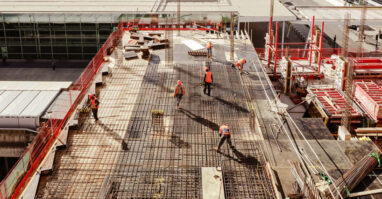Contractors have always had to keep a close watch on technology trends to stay on the leading edge of the industry. But, historically, they have had more time for strategic planning ahead of adopting new technology. Since the pandemic, taking part in the digital transformation is a high-stakes, high-velocity endeavor. Leveraging the latest technology has become a necessary part of driving growth, increasing efficiency, boosting production, mitigating risks, and evolving with the changing needs of the industry and market. Here’s a look at some of the top technology trends in the construction industry.
Enterprise Integration
In today’s remote atmosphere, enterprise integration helps contractors access pertinent data and connect via user-friendly applications across various devices. In an era of 5G wireless connectivity, contractors can connect the office to the field. Project meetings can take place virtually to move forward without the need to gather in person.
When contractors use automated and cloud-based solutions, such as job costing, risk assessment, asset management, project management, or customer relationship management software, they can access the information they need anywhere, anytime. By automating the request for information (RFI) process, construction firms can reduce bottlenecks, paperwork, and travel while accelerating decision-making and progress.
Internet of Things (IoT)
Equipment loss and safety issues are significant liabilities in construction. Through IoT, contractors can install network-connected sensors to their equipment to perform real-time inspections and performance assessments, ensure on-site accountability, and take accurate measurements using smart devices.
These sensors may also be used in wearable safety equipment. Contractors often use drones for aerial imaging, but AI-powered image recognition can help contractors identify at-risk materials or high-risk trends in worker behavior.
Data Analytics
Data analytics is a game-changer in the construction industry. Access to data goes hand-in-hand with enterprise integration and IoT. By employing automated solutions, contractors can improve transparency significantly, which provides advantages now and in the future. For example, job costing software allows contractors to track projects in real-time to make adjustments before taking a loss. Because it compiles historical data on actual costs over time, this software also allows contractors to analyze future job profitability and make estimates with greater accuracy and less risk.
Through IoT, they can gather valuable insights on worker safety and accountability, job site and material risks, and equipment performance. Predictive analysis technology uses AI, statistics, forecasting analytics, performance management, trend analysis, and simulation modeling. In combination with IoT sensor data, this technology can help contractors with predictive maintenance.
Augmented Reality (AR)
Contractors can use AR applications for training purposes or to detect errors before breaking ground. AR applications can show machine operators fuel levels or alert them of maintenance issues in real-time. AR applications for wearable smart devices, such as smart glasses and smart helmets, allow users to superimpose safety warnings or data points (such as temperature or pressure), and assembly and repair instructions directly onto the job site.
3D-modeling applications help contractors transform plans into three-dimensional holograms. Using a smartphone or tablet, contractors can use building site monitoring applications to overlay 3D buildings in the planning process to avoid errors, unexpected costs, and rework.
Robotics
Robots are often used to perform repetitive tasks, such as bricklaying or painting. They can also help contractors complete work during labor shortages and perform work in dangerous environments to reduce injuries.
Cobots, which are AI-enabled robots designed to work alongside workers, are less costly, easier to program, and more versatile. Cobots can improve quality and consistency by applying pressure, welding, fastening, or making cuts in the exact same way across every run, which means they can improve your products and processes. According to Interact Analysis, by 2028, annual cobot revenues will reach nearly $2 billion.
Modular & Industrialized Construction
Labor shortages and the increase in cost and demand for resources have shifted the industry toward an innovative manufacturing approach. In modular construction, project components are produced offsite on a large scale and shipped to the job site for assembly. Because of its effectiveness and efficiency, modular construction is an increasingly popular option. According to MarketsandMarkets, the modular construction market will reach over $100 billion by 2025.
Industrialized construction (IC) is an expansion of modular construction movement. In IC, contractors use digital twins, which are exact replicas of physical assets, processes and systems, to support building maintenance and operations. Digital twins work as prototypes, collecting real-world information to prevent costly rework and mistakes. Contractors also use 5D Building Information Modeling (BIM) technology to create digital representations of physical buildings. These technologies limit downtown and accelerate and automate traditional design, production, and operational processes.
Contractors are also turning to IC to reduce costs associated with waste. The price of plastic products, steel mill and other metal products, and number two diesel has increased significantly, and the price of lumber is back on the rise. By using innovative materials in their IC processes, contractors can align themselves with industry trends that employ sustainable and green construction methods, use fewer resources, and result in a lower carbon footprint.
Contact ARB
ARB’s Construction Advisory Services Team is dedicated to helping contractors maximize both the financial and operational aspects of their businesses, so we stay up-to-date on construction technology trends and other issues affecting your industry. We provide industry-specialized accounting, tax, and advisory services for construction start-ups, established firms, and the contractors that own them.
I help contractors with software selection and implementation, profitability analyses, forecasts, projections, job costing, and more. Contact me today if you have any questions or would like to discuss your company’s tax, accounting, and business advisory needs.
by David Jean, CPA, CCIFP, CExP
David Jean is a principal at ARB and the Practice Leader for the firm’s Construction & Real Estate, Succession Planning, Professional Services Firms, and Business Advisory Services Teams. He provides specialized tax, accounting, and business advisory services primarily to construction, real estate, and manufacturing companies. David is a member of the NASBP’s CPA Advisory Council. As a Certified Exit Planner and the Director of Altus Exit Strategies, David helps business owners create, implement, and execute successful succession and exit plans.





